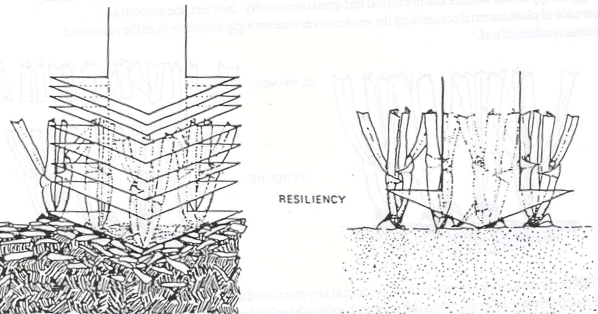Sometimes the things we see every day become so familiar that we stop noticing them and this can be the case with the most obvious of performance signals on the bowling green. We can learn a lot from just being a bit more observant of the every day activities we get involved in as greenkeepers.
There are two aspects of green maintenance that sound so obvious that they are easy to dismiss:
- How much grass comes off when you mow? This is called Yield
- And how much grass is left after you mow? Which is called Verdure
It might sound ridiculous to make up special words like Yield and Verdure for fundamental factors like this, but they are important and give us much more information than we might first realise.
Yield
This is the measure of how much material comes off when we mow the green. Of course we aren’t interested in the yield in the same way a farmer would be. Our job isn’t to grow as much grass as possible; our job is to grow dense healthy turf that supports the preparation of the green surface to a high performance level, consistently throughout the season. Turf scientists might take the clippings, dry them and weigh the remaining dry tissue matter to come up with an accurate measure of Yield in kg/Ha, but my old boss at my first greenkeeping job had a much more straightforward and instant way of monitoring this. When I returned to the maintenance shed after cutting 18 golf greens in the morning he would simply ask; “did you get much grass?”
Unscientific as that may sound, it’s as good a measure as any to an experienced greenkeeper who treads the same piece of ground every day in life. The subtle nuances of Yield Fluctuation (the increase or decrease in boxes of grass removed to you and me) can tell you a lot about your green’s condition.
Assuming that everything else such as mowing height, sharpness of mower, weather conditions and timing of cut are roughly the same, we can make a judgement of the condition of the green relative to previous cuts we’ve made, whether that was yesterday or last year at the same time. But what can we ascertain from this?
Nutrition
Increasing yield is common after Nitrogen fertiliser has been applied. Fertiliser applications, particularly when using granular fertilisers tend to have a distinct life span pattern and the green will go through a growth pattern after application. For example a few days after application of fertiliser like this it will be common for the yield to increase steadily day after day. At some point after the first flush of growth, yield will level off and stay roughly the same for several weeks. Then it is likely that yield will steadily reduce until a new application of Nitrogen is made and the pattern will repeat. Being able to judge when the next application needs to be made is a skill picked up by greenkeepers over time and relies a lot on watching the grass box filling up. By having this feel for what’s happening in terms of growth patterns, you can form a better understanding of the right fertiliser program, application rates and frequency of application for your green at any given time.
Moisture
Another key contributor to yield will be the level of plant available moisture in the soil at any given time. Yield will decrease as this dips below optimum and will increase as you get closer to field capacity. There’s a close connection with nutrition here too as fertiliser needs a good amount of soil water for the nutrient ions to be able to get into the soil solution where they can be taken up by the plant roots.
Cultural Practices
The other non-mowing cultural practices you carry out on your green will also influence yield. Jobs such as scarifying and aeration of any kind will have the effect of introducing oxygen to the soil which will increase microbial activity, releasing nutrients which might increase yield.
Of course, the object is to try to create a steady growth pattern that allows the green to recover from the rigours of play and maintenance and to exhibit all of the other key components of performance we have looked at over the previous 9 articles. Measuring yield even by just counting the boxes of grass collected every day is a great starting point in getting a feel for your green’s performance and the effect that your work has on it over time.
Verdure
This is a measure of the green plant material that is left after mowing. Oh come on John, I just call that grass, I hear you say, but Verdure is just a little more complex (and useful) than that.
For example in any turf grass species, turf resiliency and rigidity will increase when you leave more tissue on the plant i.e. raise the blades. This will generally increase wear resistance too. Grass will generally be healthier and more robust at higher mowing heights and that is why I recommend raising the height during drought conditions and of course in winter.





